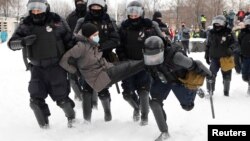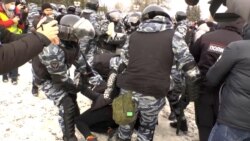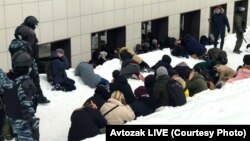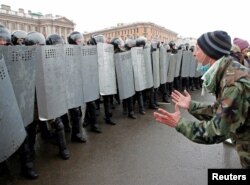Indiscriminate detentions and police violence against peaceful participants in Russia’s January 31 demonstrations for the release of jailed opposition leader Aleksei Navalny could ultimately backfire on President Vladimir Putin’s government during the 2021 election year, some Russian analysts believe.
“The news is that people are starting to understand that we’re living in a police state …” independent political analyst Dmitry Oreshkin commented during a live Current Time special on the protests. “I wouldn’t say the majority, but a significant part of the population.”
By late evening on January 31, 5,135 confirmed detentions had taken place in 86 locations nationwide, the non-governmental police watchdog OVD-Info reported. That compares with an estimated total of 4,033 detentions in 186 towns and cities for the initial pro-Navalny demonstrations on January 23.
Out of the 86 cities, Moscow (1,653 detainees) and St. Petersburg (1,159 detainees) headlined OVD-Info’s list of verified detentions on January 31, but several other cities (Krasnoyarsk, Nizhny Novgorod, Tver, Voronezh, Vladivostok, and Novosibirsk) had more than 100 detainees as well.
With Moscow and St. Petersburg’s subway systems partly shut down and access blocked to downtown areas, turnout in Russia’s two largest cities appeared far lower than the previous weekend. Crowds in the Siberian cities of Irkutsk and Tomsk sometimes seemed to outnumber the clutches of people gathered in Moscow and Petersburg. Some observers attributed that to fear of police brutality or massive detentions.
No matter the crowd size, police officers’ systematic use of beatings and electric shock batons was documented in both Moscow and St. Petersburg.
Near Moscow’s Matrosskaya Tishina detention center, where Navalny is held, police used a shock baton on one man who was not violently resisting detention. Elsewhere on the same street, several OMON riot police pushed a handful of unarmed demonstrators into a corner, with one officer repeatedly beating a kneeling girl on the back with his baton.
Several cases of shock batons also occurred in St. Petersburg, the city’s ombudsman, Aleksandr Shishlov, told Current Time correspondent Yury Baranyuk.
In one instance, a police officer went still further, pulling out his pistol and aiming it at several protesters shouting “Leave! Leave!” as several officers and he walked along a St. Petersburg street. The independent local news site Fontanka.ru filmed the scene.
Displays of force were also noticed in Russia’s regions. In the Siberian city of Irkutsk, Aleksei Zhemchuzhnikov, a member of the Civic Chamber, a civil-society body that advises the government, called the day “historic.”
“For the first time today, we saw ‘cosmonauts,’” commented Zhemchuzhnikov, using the slang term for helmeted riot police in padded uniforms. “What’s long been a given for Moscow, we saw today in Irkutsk for the first time. I consider this a rather significant event.”
In total, 30 people were detained in Irkutsk, according to OVD-Info.
In Kazan, seat of the Tatarstan region, one photo showed several detainees lying in the snow in sub-freezing temperatures while riot police stood guard. Overall, 76 people were believed detained in the city.
As on January 23, riot police in Moscow appeared to detain many people – primarily, young men -- randomly and without explaining the cause.
“They just said, ‘Let’s go’ and took me by the arm,” yelled out one man in a green bubble coat, as police rushed him to a waiting paddy wagon near Krasnye Vorota subway station. “Just like that.”
Veteran broadcast journalist Nikolai Svanidze, a member of President Putin’s Council for Civil Society and Human Rights, was picked up as well as he exited the city’s Sukharevskaya subway station. Police apparently paid no attention to his identity card as a protest monitor.
No reason was given for his detention. “They just take everyone,” commented the 65-year-old Svanidze after his release. “Somehow, I attracted their attention to take some kind of measures.”
“Maybe they liked my hat,” he quipped, in reference to his bushy “ushanka,” a fur hat with ear flaps.
After 10-20 minutes inside a police van, Svanidze was released.
“We called someone, someone called someone else …” elaborated Svanidze’s Council colleague, print journalist Aleksandr Verkhovsky. “But this, of course, is easy to do with a member of the SPCh (Human Rights Council), but with an ordinary citizen such a move won’t work.”
Svanidze commented that there had been “no drama” during his detention or in the police van, and that the police had not roughhoused him.
As of yet, no plans to open investigations into excessive use of police force or improper detentions have been announced.
Verkhovsky commented that he hoped the Civil Society and Human Rights Council would discuss the behavior of police “in some official meeting” next week, but cautioned that the Council, an advisory body, can do little.
When police or officials feel that they are under threat, he added, “they start to take nervous decisions … If they stop feeling like they’re under some kind of scary threat, then, perhaps, [our] negotiations [with them] will be more sensible as a result. But perhaps not.”
Nikolai Petrov, a political scientist at Moscow’s Higher School of Economics, noted that the Russian authorities are eager not to allow “a long repetition of protests” as in Belarus, where turbulent demonstrations against Alyaksandr Lukashenka’s official election as president have continued since August 2020. Russia faces a parliamentary election in September and, so, “with its first move, is trying to crush the protest wave,” Petrov said.
Like in Belarus, any such aim could have sparked police on January 31 to take stronger notice of media.
For unclear reasons, 82 journalists were detained throughout Russia, OVD-Info reported.
In St. Petersburg, where seven journalists were detained, one riot police officer threatened Current Time correspondent Yury Baranyuk with his baton when Baranyuk attempted to interview a detainee.
Another apparent St. Petersburg journalist, wearing the bright yellow vest that designated media, was filmed being beaten by police as he writhed in the snow.
In Moscow, 22 journalists were detained, including one filming the detention of protesters near Sukharevskaya subway station.
A tweet from the U.S. embassy in Moscow condemning the detention of journalists again prompted the Russian Foreign Ministry to warn the embassy and U.S. State Department against “interference in domestic affairs.”
A PA system announced outside Moscow’s Sukharevskaya metro station that the police were defending public order, but some observers reckoned the opposite.
“The authorities themselves destabilize the situation” with “a strategy of force toward the civilian population,” commented Oreshkin.
“Broadening the circle of repression will not fail to lead to information about the protests being spread to the max and the level of sympathy toward the protests will grow,” agreed political analyst Aleksandr Kynev.
As at the January 23 protests, most interviewed protest participants in Moscow insisted that they did not fear the police. “What’s there to fear?” asked one young man in a red parka and banana-yellow ski hat. “It’s scary for the future, that’s what’s scary.”
Aside from perceived injustices and abuses of power, some interviewed protesters cited a January 19 investigation by Navalny into a palatial Black Sea estate allegedly built for President Putin as what spurred them to take to the streets. The video has attracted 105 million views on YouTube to date.
Navalny's January 28 bid for a Moscow court to scrap his 30-day pre-trial confinement was rejected. He faces trial on February 2 for allegedly violating the terms of an earlier 3 1/2-year conditional sentence for supposed fraud.
What coordination existed for the Moscow protests appeared to come from Navalny’s social-media channels, although the arrest or detention of several of the politician’s chief activists affected the unauthorized rallies’ organization, some commentators believe.
Ahead of the protest, the highly visible Navalny activist Lyubov Sobol, a lawyer with his Anti-Corruption Foundation, and his brother, Oleg Navalny, were placed under house arrest until March 23 for allegedly violating COVID-19 restrictions by attending the January 23 protest in Moscow.
The coordinator of Navalny’s Moscow office, Oleg Stepanov, also was placed under house arrest for the same term.
In Nizhny Novgorod, the detained coordinator of Navalny’s office, Roman Tregubov, recorded a video statement in which he claimed that he had split with the opposition leader and urged viewers not to participate in an unsanctioned protest. The video was released by the Telegram channel Siloviki (Security Forces), believed to have some connection to law enforcement.
As at the January 23 protest, Navalny’s wife, Yulia Navalnaya, was also detained and later released.
Yet these tactics did little to convince one protester to rethink her own participation.
“I believe the authorities are very strongly afraid of something,” said one young woman in a violet ski hat near Moscow’s Komsomolskaya subway station. “And for that reason, all of this is happening.”
“We’re behaving according to the constitution,” which authorizes public demonstrations and freedom of speech, she emphasized. “We just want to be heard. That’s all.”
-With additional reporting from Interfax, Izvestia, and Reuters


















